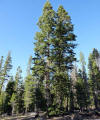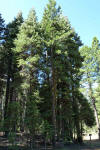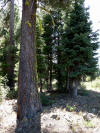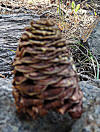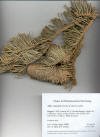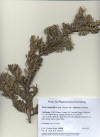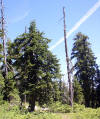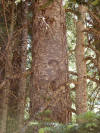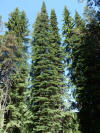 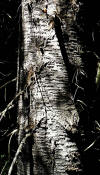  Abies grandis x lasiocarpa? Idaho. Idaho Co.: Clearwater NF, along the Lewis and Clark Trail (Hwy 12) west of Lolo Pass 20 July 2010 |
Abies concolor |
Abies concolor |
|
Abies concolor |
Abies
cf procera
(cone) |
Abies concolor |
|
Abies concolor |
Abies concolor |
Abies concolor |
|
Abies concolor Kern Co., CA. Tehachapi
Mts., Tejon Ranch Conservancy |
Abies concolor |
Abies concolor
|
|
Abies concolor OR: Fremont NF, White Horse Creek
|
Abies concolor |
Abies concolor |
|
Abies concolor
|
Abies grandis (Grand fir) Near Aberdeen, WA
|
Abies grandis (Grand fir) Idaho: North-central, Clearwater Natl. For., Eldorado Creek near jct. with Dollar Creek, 46º17.964, 115º38.776, elev. 3,540 ft, wetland prairie with dominant Veratrum californicum surrounded by forest of Englemann spruce, western red cedar. 26 July 2011 |
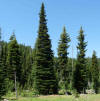   Abies lasiocarpa
var. lasiocarpa |
Abies lasiocarpa
ssp. bifolia |
Abies lasiocarpa
ssp. lasiocarpa |
|
Abies magnifica
|
Abies magnifica var. shastensis
|
Abies magnifica var. shastensis
|
|
Abies magnifica var. crutchfieldii |
Abies sp. Gold Creek, Fremont National Forest, |
Abies procera |
|
Trees and Shrubs of Kern County (Jan 2013) Abies Evergreen trees; needles ± spreading upwards (erect) to horizontally along two sides of the branch, grooved on upper (adaxial) side, notched or rounded to apex, persisting 5 yrs or more; pollen cones sausage shaped (cylndric or subcylindric, curved), often in axils of successive leaves on branchlets of the current season, varying in color from red to yellow or purple or green; seed cones mature before end of season, the scales falling from a central axis, which remains attached to branch as a spike; seeds winged. ±42 spp. in temperate regions of northern hemisphere; 6 of 11 North American spp. used medicinally by native Americans (Hunt 1993; Moerman); 3 with antitumor activity from aqueous or aqueous/ethanol extracts in NCI assays sensitive to tannins (A. concolor stembark, A. magnifica twig-leaf, A. religiosa (Pinus religiosa Kunth 1817) Schlechtendal & Chamisso 1830 twig-leaf (from Mexico). Ninety-four secondary chemical constituents isolated from A. fabri (Keteleeria fabri Masters 1902) Craib 1919 , largely terpenoids, also lignans, flavonoids and miscellaneous compounds (Y. L. Li et al. 2015). Needles twist near base where they attach to twigs.... ...................................... Abies concolor
Needles sharply bent near base so that part of the needle is pressed
Abies concolor (Picea concolor Gordon & Glendinning 1858) Lindley ex Hildebrand 1861. White fir. Tree with aromatic needles and upright cones on branches well above the ground; bark smooth and grayish white when young, becoming deeply furrowed with age, gray to reddish; needles slightly 4-angled, with whitish stomata bands on all surfaces, variable in arrangement along twigs, on some plants leaves on lower branches appear to spread horizontally, while on higher or younger branches they spread directly upwards; in other locations, they may all spread upwards but then still identified by the twisted leaf stalk. Generally a montane species of conifer forests in western U.S. to northern Mexico. White fir forest and white fir-sugar pine forest, which occur in Kern Co., recognized in MCV2 when >60% relative cover in canopy and the most common reproducing tree in the understory, or includes sugar pine when its absolute cover is >2% with 50% white fir cover. Type from mountains of New Mexico. Kern County: Common in the montane forests of Kern County. Abies magnifica A. Murray 1863 var. critchfieldii Lanner 2010. Critchfield red fir. Similar to the preceding, leaf stalks and part of the needle near base sharply bent and pressed against the twig. The variety found only in the southern Sierra Nevada. Red fir forest recognized in MCV2 when >50% relative cover in the tree canopy and reproducing in the understory. Type from Tulare Co., Mountain Home State Forest, mixed conifer forest, south slope, 6,600 ft, CA. Kern County: Sunday Peak, the southernmost distribution of the species and variety in the Sierra Nevada, 2,2002,400 m.
BONAP Distribution maps for species of Abies, North America synthesis. http://www.bonap.org/dist%20maps%202009/Abies.html
|
||
|
Dubey S, S. Saha S, and S.A. 2015. In vitro anti-cataract evaluation of standardised Abies pindrow leaf extract using isolated goat lenses. Nat. Prod. Res. 29(12):114548. Oxidative stress is known to spark off the pathogenesis of cataract. Antioxidant potential of Abies pindrow Royle leaf extract (APE) is well established in the literature. In this context, standard aqueous leaf extract of this plant was evaluated for its role in hydrogen peroxide-induced cataract in isolated goat lenses using varying concentrations (5, 10, 15 and 20 mg/mL). Total phenol and flavonoidal content was evaluated and found to be high in concentration. Biochemical parameters, namely superoxide dismutase (SOD), glutathione (GSH), total protein content (TPC) and malondialdehyde (MDA), were evaluated. SOD, GSH and TPC formation was found to increase proportionally with increasing concentration. However, MDA level decreased significantly as the concentration of the extract increased. The results suggest that the extract under investigation can delay the onset and/or prevent the progression of cataract. Its anti-cataract potential may be attributed to the presence of high phenolics and flavonoids in APE. Photographic evaluation, further, confirmed the observation.
Li, Y.L., Y. X.
Gao, H. Z. Jin, L. Shan, W. L. Chang, X. W. Yang, H. W. Zeng, N. Wang,
A. Steinmetz, and W. D. Zhang. 2015. Chemical constituents of Abies
fabri. Phytochemistry 117: 135143. Semerikova, S.A. and V. L. Semerikov. 2014. [Molecular phylogenetic analysis of the genus Abies (Pinaceae) based on the nucleotide sequence of chloroplast DNA]. Genetika 50(1):1225 [In Russian]. A phylogenetic study of firs (Abies Mill.) was conducted using nucleotide sequences of several chloroplast DNA regions with a total length of 5580 bp. The analysis included 37 taxa, which represented the main evolutionary lineages of the genus, and Keteleeria daviana. According to phylogenetic reconstruction the Abies species were subdivided into six main groups, generally corresponding to their geographic distribution. The phylogenetic tree had three basal clades. All of these clades contained American species, and only one of them contained Eurasian species. The divergence time calibrations, based on paleobotanical data and the chloroplast DNA mutation rate estimates in Pinaceae, produced similar results. The age of diversification among the clades of the present-day Abies was estimated as the end of the Oligocene-beginning of Miocene. The age of the separation of Mediterranean firs from the Asian-North American branch corresponds to the Miocene. The age of diversification within the young groups of Mediterranean, Asian, and boreal American firs (A. lasiocarpa, A. balsamea, A. fraseri) was estimated as the Pliocene-Pleistocene. Based on the phylogenetic reconstruction obtained, the most plausible biogeographic scenarios were suggested. It is noted that the existing systematic classification of the genus Abies strongly contradicts with phylogenetic reconstruction and requires revision. Wajs-Bonikowska A., M. Sienkiewicz, A. Stobiecka, A. Maciąg, L. Szoka, and E. Karna. 2015. Chemical composition and biological activity of Abies alba and A. koreana seed and cone essential oils and characterization of their seed hydrolates. Chem. Biodivers.12(3): 40718. The chemical composition, including the enantiomeric excess of the main terpenes, the antimicrobial and antiradical activities, as well as the cytotoxicity of Abies alba and A. koreana seed and cone essential oils were investigated. Additionally, their seed hydrolates were characterized. In the examined oils and hydrolates, a total of 174 compounds were identified, which comprised 95.6-99.9% of the volatiles. The essential oils were mainly composed of monoterpene hydrocarbons, whereas the composition of the hydrolates, differing from the seed oils of the corresponding fir species, consisted mainly of oxygenated derivatives of sesquiterpenes. The seed and cone essential oils of both firs exhibited DPPH-radical-scavenging properties and low antibacterial activity against the bacterial strains tested. Moreover, they evoked only low cytotoxicity towards normal fibroblasts and the two cancer cell lines MCF-7 and MDA-MBA-231. At concentrations up to 50 μg/ml, all essential oils were safe in relation to normal fibroblasts. Although they induced cytotoxicity towards the cancer cells at concentrations slightly lower than those required for the inhibition of fibroblast proliferation, their influence on cancer cells was weak, with IC50 values similar to those observed towards normal fibroblasts. Xiang, Q.P., R. Wei, Y. Z. Shao, Z. Y. Yang, X. Q. Wang, and X. C. Zhang. 2015. Phylogenetic relationships, possible ancient hybridization, and biogeographic history of Abies (Pinaceae) based on data from nuclear, plastid, and mitochondrial genomes. Mol Phylogenet. Evol. 82 Pt A: 114, 341-2 (erratum). Abies, the second largest genus of Pinaceae, consists of approximately 48 species occurring in the north temperate region. Previous molecular phylogenetic studies improved our understanding of relationships within the genus, but were limited by relying on only DNA sequence data from single genome and low taxonomic sampling. Here we use DNA data from three genomes (sequences of internal transcribed spacer of nrITS, three chloroplast DNA intergenic spacers, and two mitochondrial intergenic spacers) from 42 species to elucidate species relationships and construct the biogeographic history of Abies. We further estimated the divergence times of intercontinental disjunction using a relaxed molecular clock calibrated with three macro-fossils. Our phylogenetic analyses recovered six robust clades largely consistent with previous classifications of sections. A sister relationship between the eastern Asian and Europe-Mediterranean clades was highly supported. The monophyly of section Balsamea, disjunct in Far East and western North America, is supported by the nrITS data but not by the cpDNA data. Discordance on placement of section Balsamea between the paternally inherited cpDNA and maternally inherited mtDNA trees was also observed. The data suggested that ancient hybridization was likely involved in the origin of sect. Balsamea. Results from biogeographic analyses and divergence time estimation suggested an origin and early diversification of Abies in an area of high latitude around the Pacific during the Eocene. The present disjunction in eastern Asia and Europe-Mediterranean area of Abies was likely the result of southward migration and isolation by the Turgai Strait in the Late Eocene. An 'out-of-America' migration, for the origin of an eastern Asian and western North American disjunct species pairs in section Amabilis was supported. The results suggested a western North American origin of the section with subsequent dispersal across the Bering Land Bridge (BLB) to Japan during the Middle Miocene
|
||
